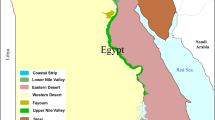Abstract
In this study, a total of 27 species of dragonfly and damselfly larvae were identified, including 14 species from suborder Anisoptera and 13 from Zygoptera. The dominant species are Libellula quadrimaculata, Enallagma cyathigerum, and Erythromma najas. Frequently occurring species are Coenagrion hastulatum, C. lunulatum, C. pulchellum, Ischnura elegans, Platycnemis pennipes, Lestes virens, and Libellula depressa. Rare species are Lestes sponsa, Libellula fulva, Gomphus flavipes, Gomphus vulgatissimus, Sympetrum flaveolum, Aeshna viridis, Ae. cyanea, Ae. grandis, Ae. mixta, Calopteryx splendens, C. virgo, and Ophiogomphus cecilia.
Similar content being viewed by others
References
Bakanov, A.I., Quantitative assessment of dominance in ecological communities, in Kolichestvennye metody ekologii i gidrobiologii (Quantitative Methods of Ecology and Hydrobiology), Tolyatti: Inst. Ekol. Volzhsk. Basseina RAN, 2005, pp. 37–67.
Popova, A.N., Lichinki strekoz fauny SSSR (Odonata) (Larvae of Dragonflies (Odonata) of the Fauna of the USSR), Moscow: Izd. AN SSSR, 1953.
Semenchenko, V.P., Printsipy i sistemy bioindikatsii tekuchikh vod (Principles and Systems of Bioindication of Flowing Waters), Minsk: Orekh, 2004.
Skvortsov, V.E., Strekozy Vostochnoi Evropy i Kavkaza: atlas-opredelitel' (Dragonflies of Eastern Europe and Caucasus: An Identification Guide and Atlas), Moscow: Tovar. Nauch. Izd. KMK, 2010.
Spuris, Z.D., Order Odonata—dragonflies, in Opredelitel’ nasekomykh Evropeiskoi chasti SSSR. Nizshie, drevnekrylye, s nepolnym prevrashcheniem (Identification Guide to Insects of the European Part of the USSR: Lower Insects, Palaeoptera, and Insects with Incomplete Metamorphosis), Moscow: Nauka, 1965, vol. 1, pp. 137–161.
Stanionite, A.P., Fauna of dragonfly larvae in the water basins around the city of Vilnius, Tr. AN Lit. SSR, Ser. B, 1962, no. 1 (27), pp. 153–160.
Taranova, V.M., Seasonal development of the fauna of dragonflies (Odonata) in coastal waters of the Rybinsk Reservoir and adjacent water bodies, in Biologiya, morfologiya i sistematika vodnykh bespozvonochnykh (Biology, Morphology, and Systematics of Aquatic Invertebrates), Leningrad: Nauka, 1980, pp. 145–153.
Tumilovich, O.A., Odonatofauna of the Kurshskaya kosa National Park, in Znacheniya ta perspektivi statsionarnikh doslidzhen’ dlya zberezheniya bioriznomanittya: Mater. mizhnar. nauk. konf. (Role and Prospects of Stationary Observations for Biodiversity Conservation), Lviv, 2008, pp. 410–411.
Tumilovich, O.A., The fauna of dragonflies of Kaliningrad region, Uch. Zap. Kazan. Gos. Univ., 2009, vol. 151, pp. 192–196.
Kharitonov, A.Yu., Dragonflies as massive components of aquatic biocenoses, in Biologicheskie resursy Zapadnoi Sibiri i ikh okhrana: Mater. nauch. konf. molodykh uchenykh (Biological Resources of Western Siberia and Their Protection: Proc. Sci. Conf. Young Scientists), Novosibirsk, 1975, pp. 63–64.
Bernard, R., Buczyńsky, P., and Tończyk, G., Present state, threats and conservation of dragonflies (Odonata) in Poland, Nat. Conserv., 2002, vol. 59, pp. 53–71.
Bernard, R., Buczyńsky, P., and Tończyk, G., Atlas rozmieszczeniawazek (Odonata) w Polsce. Poznań: Bogucki Wydawnictwo Naukowe, 2009, p. 256.
Bernard, R. and Ivinskis, P., Orthetrumbrunneum (Fonscolombe, 1837), a new dragonfly species in Lithuania (Odonata: Libellulidae), Acta Zool. Lituanica, 2004, vol. 114, no. 3, pp. 31–36.
Buczyńsky, P. and Moroz, M.D., Notes on the occurrence of some Mediterranean dragonflies (Odonata) in Belarus, Polish J. Entomol., 2008, vol. 77, pp. 67–74.
Dijkstra, K.-D.B. and Lewington, R., Field Guide to the Dragonflies of Britain and Europe, Dorset: British Wildlife Publ., 2006.
Flenner, I., Forest Lakes Affected by Forestry—How Resilient Are Dragonfly Communities to Logging in Central Sweden, Halmstad: Halmstad Univ. School of Busines and Engineering, 2007.
Hassall, Ch., Thompson, D.J., French, G.C., and Harvey, I.F., Historical changes in the phenology of British Odonata are related to climate, Global Change Biol., 2007, vol. 13, no. 5, pp. 933–941.
Le Roi, O., Die Odonaten von Ostpreussen, Schriften der Physikalisch-ökonomischen Gesellschaft Konigsberg, Leipzig, 1911, vol. 52, pp. 13–30.
Tończyk, G., Dragonfly (Odonata) of the Nibieskie Źródła Nature Reserve near Tomasźowa Mazowieckego (Central Poland), Poznan. Acta Univ. Lodsiensis. Folia Limnol., 2000, vol. 7, pp. 79–85.
Tumilovich, O., New species of odonatofauna of the Kaliningrad region, in Biodiversity, Protection and Prospects of Baltic Seashore Habitats: Abstract, Klaipeda, 2009, pp. 49–50.
Author information
Authors and Affiliations
Corresponding author
Additional information
Original Russian Text © O.A. Tumylovich, 2016, published in Biologiya Vnutrennykh Vod, 2016, No. 4, pp. 18–22.
Rights and permissions
About this article
Cite this article
Tumylovich, O.A. Odonata larvae of Kaliningrad oblast: Species composition and distributional features. Inland Water Biol 9, 350–354 (2016). https://doi.org/10.1134/S1995082916040155
Received:
Published:
Issue Date:
DOI: https://doi.org/10.1134/S1995082916040155




